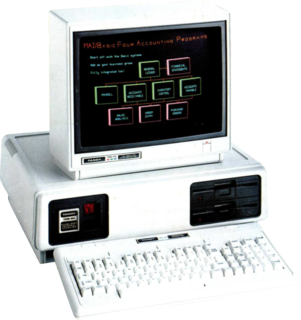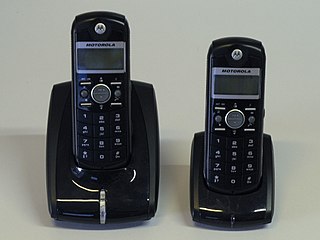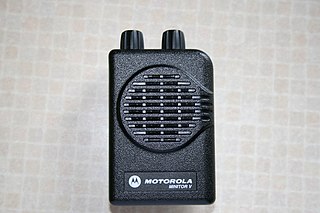
The TRS-80 Micro Computer System is a desktop microcomputer launched in 1977 and sold by Tandy Corporation through their Radio Shack stores. The name is an abbreviation of Tandy Radio Shack, Z80 [microprocessor]. It is one of the earliest mass-produced and mass-marketed retail home computers.

Oak Ridge National Laboratory (ORNL) is a U.S. multiprogram science and technology national laboratory sponsored by the U.S. Department of Energy (DOE) and administered, managed, and operated by UT–Battelle as a federally funded research and development center (FFRDC) under a contract with the DOE, located in Oak Ridge, Tennessee.

X10 is a protocol for communication among electronic devices used for home automation (domotics). It primarily uses power line wiring for signaling and control, where the signals involve brief radio frequency bursts representing digital information. A wireless radio-based protocol transport is also defined.

The MCS-48 microcontroller series, Intel's first microcontroller, was originally released in 1976. Its first members were 8048, 8035 and 8748. The 8048 is probably the most prominent member of the family. Initially, this family was produced using NMOS technology. In the early 1980s, it became available in CMOS technology. It was still manufactured into the 1990s to support older designs that still used it.

NOAA Weather RadioNWR; also known as NOAA Weather Radio All Hazards is an automated 24-hour network of VHF FM weather radio stations in the United States (U.S.) that broadcast weather information directly from a nearby National Weather Service office. The routine programming cycle includes local or regional weather forecasts, synopsis, climate summaries or zone/lake/coastal waters forecasts. During severe conditions the cycle is shortened into: hazardous weather outlooks, short-term forecasts, special weather statements or tropical weather summaries. It occasionally broadcasts other non-weather related events such as national security statements, natural disaster information, environmental and public safety statements, civil emergencies, fires, evacuation orders, and other hazards sourced from the Federal Communications Commission's (FCC) Emergency Alert System. NOAA Weather Radio uses automated broadcast technology that allows for the recycling of segments featured in one broadcast cycle seamlessly into another and more regular updating of segments to each of the transmitters. It also speeds up the warning transmitting process.

The Tandy 2000 is a personal computer introduced by Radio Shack in September 1983 based on the 8 MHz Intel 80186 microprocessor running MS-DOS. By comparison, the IBM PC XT used the older 4.77 MHz Intel 8088 processor, and the IBM PC AT would later use the newer 6 MHz Intel 80286. Due to the 16-bit-wide data bus and more efficient instruction decoding of the 80186, the Tandy 2000 ran significantly faster than other PC compatibles, and slightly faster than the PC AT. The Tandy 2000 was the company's first computer built around an Intel x86 series microprocessor; previous models used the Zilog Z80 and Motorola 6809 CPUs.
Extremely high frequency (EHF) is the International Telecommunication Union (ITU) designation for the band of radio frequencies in the electromagnetic spectrum from 30 to 300 gigahertz (GHz). It lies between the super high frequency band and the far infrared band, the lower part of which is the terahertz band. Radio waves in this band have wavelengths from ten to one millimetre, so it is also called the millimetre band and radiation in this band is called millimetre waves, sometimes abbreviated MMW or mmWave. Millimetre-length electromagnetic waves were first investigated by Bengali physicist Jagadish Chandra Bose during 1894–1896, when he reached up to 60 GHz in his experiments.

A cordless telephone or portable telephone is a telephone which has a portable handset but which one can use like landline phone communication; such telephones operate using radio-frequency transmission rather than a physical insulated wire or a direct connection to a telephone line. A cordless telephone's base station connects with the telephone network through a telephone line and also includes a charger to charge the handset's batteries. The operational range is limited, usually to the same building or within some short distance from the base station.

A two-way radio is a radio that can both transmit and receive radio waves, unlike a broadcast receiver which only receives content. It is an audio (sound) transceiver, a transmitter and receiver in one unit, used for bidirectional person-to-person voice communication with other users with similar radios. Two-way radios are available in stationary, mobile, and hand-held portable models. Hand-held two-way radios are often called walkie-talkies, handie-talkies or hand-helds. Two-way radios are used by groups of geographically separated people who need to keep in continuous voice communication, such as aircraft pilots and air traffic controllers, ship captains and harbormasters, emergency services personnel like firefighters, police officers, and ambulance paramedics, taxi and delivery services, soldiers and military units, fast food and warehouse employees, and radio amateurs.

A scanner is a radio receiver that can automatically tune, or scan, two or more discrete frequencies, stopping when it finds a signal on one of them and then continuing to scan other frequencies when the initial transmission ceases.

The TRS-80 Model 100 is a portable computer introduced in 1983. It is one of the first notebook-style computers, featuring a keyboard and liquid crystal display, in a battery-powered package roughly the size and shape of a notepad or large book.

Speedpass was a keychain radio-frequency identification (RFID) device introduced in 1997 by Mobil for electronic payment. It was originally developed by Verifone. By 2004, more than seven million people possessed Speedpass tags, which could be used at approximately 10,000 Exxon, Mobil and Esso gas stations worldwide.

A trunked radio system is a two-way radio system that uses a control channel to automatically assign frequency channels to groups of user radios. In a traditional half-duplex land mobile radio system a group of users with mobile and portable two-way radios communicate over a single shared radio channel, with one user at a time talking. These systems typically have access to multiple channels, up to 40-60, so multiple groups in the same area can communicate simultaneously. In a conventional (non-trunked) system, channel selection is done manually; before use the group must decide which channel to use, and manually switch all the radios to that channel. This is an inefficient use of scarce radio channel resources because the user group must have exclusive use of their channel regardless of how much or how little they are transmitting. There is also nothing to prevent multiple groups in the same area from choosing the same channel, causing conflicts and 'cross-talk'. A trunked radio system is an advanced alternative in which the channel selection process is done automatically by a central controller (computer).

WOKI is a United States FM radio station serving the Knoxville, Tennessee, area with a news-talk format. It is owned by Cumulus Media.
A universal remote is a remote control that can be programmed to operate various brands of one or more types of consumer electronics devices. Low-end universal remotes can only control a set number of devices determined by their manufacturer, while mid- and high-end universal remotes allow the user to program in new control codes to the remote. Many remotes sold with various electronics include universal remote capabilities for other types of devices, which allows the remote to control other devices beyond the device it came with. For example, a VCR remote may be programmed to operate various brands of televisions.
Motorola Type II refers to the second generation Motorola trunked radio systems that replaced fleets and subfleets with the concept of talkgroups and individual radio IDs. There are no dependencies on fleetmaps, therefore there are no limitations on how many radio IDs can participate on a talkgroup. This allows for greater flexibility for the agency. When scanning Motorola IDs, each Type II user ID appears as an even 4- or 5-digit number without a dash.
GE Marc V is a historic U.S. format or protocol of trunked, two-way radio introduced by General Electric Mobile Radio in the early 1980s. This equipment was also sold in Australia. The product name looks and sounds similar to GE-Mark V, a turbine controller made by General Electric. GE developed the EDACS radio system based on its success with Marc V.

The Motorola Minitor is a portable, analog, receive only, voice pager typically carried by fire, rescue, and EMS personnel to alert of emergencies. The Minitor, slightly smaller than a pack of cigarettes, is carried on a person and usually left in selective call mode. When the unit is activated, the pager sounds a tone alert, followed by an announcement from a dispatcher alerting the user of a situation. After activation, the pager remains in monitor mode much like a scanner, and monitors transmissions on that channel until the unit is reset back into selective call mode either manually, or automatically after a set period of time, depending on programming.
Frequency agility is the ability of a radar system to quickly shift its operating frequency to account for atmospheric effects, jamming, mutual interference with friendly sources, or to make it more difficult to locate the radar broadcaster through radio direction finding. The term can also be applied to other fields, including lasers or traditional radio transceivers using frequency-division multiplexing, but it remains most closely associated with the radar field and these other roles generally use the more generic term "frequency hopping".

A videocassette recorder (VCR) or video recorder is an electromechanical device that records analog audio and analog video from broadcast television or other source on a removable, magnetic tape videocassette, and can play back the recording. Use of a VCR to record a television program to play back at a more convenient time is commonly referred to as timeshifting. VCRs can also play back prerecorded tapes. In the 1980s and 1990s, prerecorded videotapes were widely available for purchase and rental, and blank tapes were sold to make recordings.














